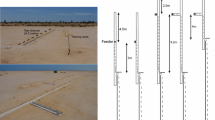Abstract
Desert ants (Cataglyphis fortis) navigate by a combination of path integration and landmark-based route memories. Their ability to correct sloped path segments to their ground distances enables them to orientate accurately even in undulating terrain. In this study, we tested whether or not ants incorporate vertical components of an itinerary into their route memory in similar ways as they do with visual landmarks and horizontal changes of direction. In two separate experiments, we trained desert ants to walk over artificial hills and later tested their acceptance of slopes within novel contexts. In the first paradigm, ants had to traverse a hill only on their outbound run, but not on their homebound trip. In a follow-up experiment, we confronted ramp-trained animals with descents in a completely new temporal and spatial context. The animals transferred their newly acquired acceptance of slopes from the outbound to the homebound run as well as to novel foraging trips. Cataglyphis obviously dissociates the experience of sloped path segments from the original context in which they appeared, thus reducing their significance as a navigational aid.




Similar content being viewed by others
References
Bisch-Knaden S, Wehner R (2003a) Landmark memories are more robust when acquired at the nest site than en route: experiments in desert ants. Naturwissenschaften 90:127–130
Bisch-Knaden S, Wehner R (2003b) Local vectors in desert ants: context-dependent landmark learning during outbound and homebound runs. J Comp Physiol A 189:181–187
Collett TS, Dillmann E, Giger AD, Wehner R (1992) Visual landmarks and route following in desert ants. J Comp Physiol A 170:435–442
Collett M, Collett TS, Bisch S, Wehner R (1998) Local and global vectors in desert ant navigation. Nature 394:269–272
Fent K (1986) Polarized skylight orientation in the desert ant Cataglyphis. J Comp Physiol A 158:145–150
Grah G, Wehner R, Ronacher B (2005) Path integration in a three-dimensional maze: ground distance estimation keeps desert ants Cataglyphis fortis on course. J Exp Biol 208:4005–4011
Grah G, Wehner R, Ronacher B (2007) Desert ants do not acquire and use a three-dimensional global vector. Frontiers in Zoology 4
Graham P, Fauria K, Collett TS (2003) The influence of beacon-aiming on the routes of wood ants. J Exp Biol 206:535–541
Knaden M, Wehner R (2005) Nest mark orientation in desert ants Cataglyphis: what does it do to the path integrator? Anim Behav 70:1349–1354
Knaden M, Wehner R (2006) Ant navigation: resetting the path integrator. J Exp Biol 209:26–31
Knaden M, Lange C, Wehner R (2006) The importance of procedural knowledge in desert-ant navigation. Curr Biol 16:R916–R917
Kohler M, Wehner R (2005) Idiosyncratic route-based memories in desert ants, Melophorus bagoti: how do they interact with path-integration vectors? Neurobiol Learn Mem 83:1–12
Müller M, Wehner R (1988) Path integration in desert ants, Cataglyphis fortis. Proc Natl Acad Sci USA 85(14):5287–5290
Ronacher B, Wehner R (1995) Desert ants Cataglyphis fortis use self-induced optic flow to measure distances travelled. J Comp Physiol A 177:21–27
Ronacher B, Gallizzi K, Wohlgemuth S, Wehner R (2000) Lateral optic flow does not influence distance estimation in the desert ant Cataglyphis fortis. J Exp Biol 203:1113–1121
Schmid-Hempel P, Schmid-Hempel R (1984) Life duration and turnover of foragers in the ant Cataglyphis bicolor (Hymenoptera, Formicidae). Insectes Sociaux 31:345–360
Wehner R (1982) Himmelsnavigation bei Insekten. Neurophysiologie und Verhalten. Neujahrsblatt der Naturforschenden Gesellschaft in Zürich 184
Wehner R (1997) The ant’s celestial compass system: spectral and polarization channels. In: Lehrer M (ed) Orientation and communication in arthropods. Birkhäuser, Basel, pp 145–185
Wehner R (2003) Desert ant navigation: how miniature brains solve complex tasks. J Comp Physiol A 189:579–588
Wehner R, Müller M (2006) The significance of direct sunlight and polarized skylight in the ant’s celestial system of navigation. Proc Natl Acad Sci USA 103:12575–12579
Wehner R, Boyer M, Loertscher F, Sommer S, Menzi U (2006) Ant navigation: one-way routes rather than maps. Curr Biol 16:75–79
Wittlinger M, Wehner R, Wolf H (2006) The ant odometer: stepping on stilts and stumps. Science 312:1965–1967
Wittlinger M, Wehner R, Wolf H (2007) The desert ant odometer: a stride integrator that accounts for stride length and walking speed. J Exp Biol 210:198–207
Wohlgemuth S, Ronacher B, Wehner R (2001) Ant odometry in the third dimension. Nature 411:795–798
Wohlgemuth S, Ronacher B, Wehner R (2002) Distance estimation in the third dimension in desert ants. J Comp Physiol A 188:273–281
Wolf H, Wehner R (2000) Pinpointing food sources: Olfactory and anemotactic orientation in desert ants, Cataglyphis fortis. J Exp Biol 203:857–868
Ziegler PE, Wehner R (1997) Time-courses of memory decay in vector-based and landmark-based systems of navigation in desert ants, Cataglyphis fortis. J Comp Physiol A 181:13–20
Acknowledgments
We thank Rüdiger Wehner for his continuous support and many discussions and for helpful comments on the manuscript. We further thank the members of the Maharès expedition 2006 for providing excellent living and working conditions. We are especially grateful to Anne Hanschke and Julja Koch for their valuable assistance in the field. This research was financially supported by the Volkswagen-Stiftung (grant to B.R.). The experiments comply with the “Principles of animal care”, publication No. 86-23, revised 1985 of the National Institute of Health, and also with the current laws of Tunisia.
Author information
Authors and Affiliations
Corresponding author
Rights and permissions
About this article
Cite this article
Grah, G., Ronacher, B. Three-dimensional orientation in desert ants: context-independent memorisation and recall of sloped path segments. J Comp Physiol A 194, 517–522 (2008). https://doi.org/10.1007/s00359-008-0324-4
Received:
Revised:
Accepted:
Published:
Issue Date:
DOI: https://doi.org/10.1007/s00359-008-0324-4




